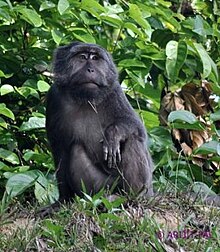
The macaques constitute a genus (Macaca) of gregarious Old World monkeys of the subfamily Cercopithecinae. The 23 species of macaques inhabit ranges throughout Asia, North Africa, and Europe. Macaques are principally frugivorous, although their diet also includes seeds, leaves, flowers, and tree bark. Some species such as the long-tailed macaque will supplement their diets with small amounts of meat from shellfish, insects, and small mammals. On average, a southern pig-tailed macaque in Malaysia eats about 70 large rats each year. All macaque social groups are arranged around dominant matriarchs.

The crab-eating macaque, also known as the long-tailed macaque and referred to as the cynomolgus monkey in laboratories, is a cercopithecine primate native to Southeast Asia. A species of macaque, the crab-eating macaque has a long history alongside humans. The species has been variously seen as an agricultural pest, a sacred animal, and, more recently, the subject of medical experiments.

The rhesus macaque, colloquially rhesus monkey, is a species of Old World monkey. There are between six and nine recognised subspecies that are split between two groups, the Chinese-derived and the Indian-derived. Generally brown or grey in colour, it is 47–53 cm (19–21 in) in length with a 20.7–22.9 cm (8.1–9.0 in) tail and weighs 5.3–7.7 kg (12–17 lb). It is native to South, Central, and Southeast Asia and has the widest geographic range of all non-human primates, occupying a great diversity of altitudes and a great variety of habitats, from grasslands to arid and forested areas, but also close to human settlements. Feral colonies are found in the United States, thought to be either released by humans or escapees after hurricanes destroyed zoo and wildlife park facilities.

The Barbary macaque, also known as Barbary ape, is a macaque species native to the Atlas Mountains of Algeria, Tunisia and Morocco, along with a small introduced population in Gibraltar. It is the type species of the genus Macaca. The species is of particular interest because males play an atypical role in rearing young. Because of uncertain paternity, males are integral to raising all infants. Generally, Barbary macaques of both sexes and all ages contribute in alloparental care of young.
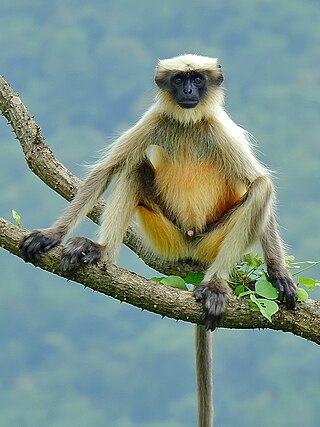
Semnopithecus is a genus of Old World monkeys native to the Indian subcontinent, with all species with the exception of two being commonly known as gray langurs. Traditionally only the species Semnopithecus entellus was recognized, but since about 2001 additional species have been recognized. The taxonomy has been in flux, but currently eight species are recognized.

The Moor macaque is a macaque monkey with brown/black body fur with a pale rump patch and pink bare skin on the rump. It has ischial callosities, which are oval-shaped. It is about 50–58.5 cm long, and eats figs, bamboo seeds, buds, sprouts, invertebrates and cereals in tropical rainforests. It is sometimes called "dog-ape" because of its dog-like muzzle, although it is no more closely related to apes than any other Old World monkey is. It is endemic to the island of Sulawesi in Indonesia, which is an important biodiversity hotspot.
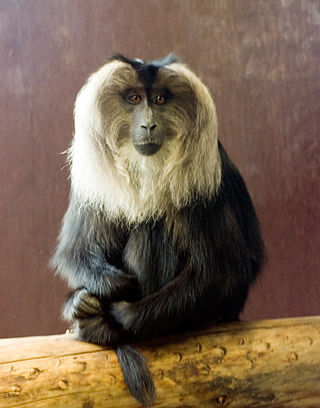
The lion-tailed macaque, also known as the wanderoo, is an Old World monkey endemic to the Western Ghats of South India.

The Celebes crested macaque, also known as the crested black macaque, Sulawesi crested macaque, or the black ape, is an Old World monkey that lives in the Tangkoko reserve in the north-eastern tip of the Indonesian island of Sulawesi (Celebes), as well as on smaller neighbouring islands.
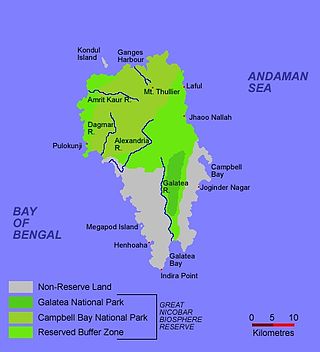
The Great Nicobar Biosphere Reserve encompasses a large part of the island of Great Nicobar, the largest of the Nicobar Islands in the Indian Union Territory of Andaman and Nicobar Islands. The Nicobars lie in the Bay of Bengal, eastern Indian Ocean, 190 km (120 mi) to the north of the Indonesian island of Sumatra. The reserve has a total core area of approximately 885 km2, surrounded by a 12 km-wide "forest buffer zone". In year 2013 it was included in the list of Man and Biosphere program of UNESCO to promote sustainable development based on local community effort and sound science.
Great Nicobar is the southernmost and largest of the Nicobar Islands of India, north of Sumatra. It is part of India, in the Nicobar district within the union territory of the Andaman and Nicobar Islands.
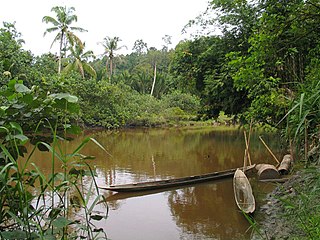
The Mentawai Islands rain forests is a tropical moist broadleaf forest ecoregion in Indonesia. It covers the Mentawai Islands, an archipelago in the Indian Ocean off the west coast of Sumatra. The islands have been separated from Sumatra since the mid-Pleistocene period, and their geographic isolation allowed the evolution of several endemic species, including 17 endemic mammals.

The Nicobar Islands rain forests is a tropical moist broadleaf forest ecoregion in the Nicobar Islands, which is part of the Andaman and Nicobar Islands union territory of India. The Nicobar Islands are in the Indian Ocean, lying north of Sumatra and south of the Andaman Islands. The islands are politically part of India, although physically closer to Southeast Asia. Millions of years of isolation from the mainland has given rise to a distinct flora and fauna, including many endemic species.

The toque macaque is a reddish-brown-coloured Old World monkey endemic to Sri Lanka, where it is known as the rilewa or rilawa, . Its name refers to the whorl of hair at the crown of the head, reminiscent of a brimless toque cap.

The Assam macaque or Assamese macaque is a macaque of the Old World monkey family native to South and Southeast Asia. Since 2008, it has been listed as Near Threatened on the IUCN Red List, as it is experiencing significant declines due to poaching, habitat degradation, and fragmentation.

The stump-tailed macaque, also called the bear macaque, is a species of macaque native to South Asia and Southeast Asia. In India, it occurs south of the Brahmaputra River, in the northeastern part of the country. Its range in India extends from Assam and Meghalaya to eastern Arunachal Pradesh, Nagaland, Manipur, Mizoram and Tripura.

The Pagai Island macaque, also known as the Pagai macaque or Bokkoi, is an Old World monkey endemic to the Mentawai Islands off the west coast of Sumatra. It is listed as critically endangered on the IUCN Red List due to its ever-shrinking habitat. Macaca pagensis formerly included the overall darker Siberut macaque as a subspecies, but this arrangement is polyphyletic, leading to the two being classified as separate species. Both were formerly considered subspecies of the southern pig-tailed macaque.
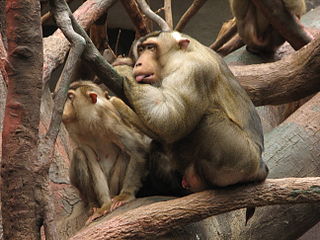
The southern pig-tailed macaque, also known as the Sundaland pig-tailed macaque and the Sunda pig-tailed macaque, is a medium-sized macaque that lives in Sundaland, southern Thailand, Malaysia, and Indonesia. It is known locally as berok.

The northern pig-tailed macaque is a vulnerable species of macaque in the subfamily Cercopithecidae. It is found in Bangladesh, Cambodia, China, India, Laos, Myanmar, Thailand, and Vietnam. Traditionally, M. leonina was considered a subspecies of the southern pig-tailed macaque, but is now classified as an individual species. In the 21st century, the pig-tailed macaque was split into the northern pig-tailed macaque species Macaca leonina and the Sundaland pig-tailed macaque species M. nemestrina. This reclassification was aided by the observation of sexual swellings and basic attributes that distinguish the two. The northern pig-tailed macaque is frugivorous and their social grouping is matriarchal, where sexual dimorphic traits can distinguish males and females. Their adaptation to omnivorous diets occur in periods of fruit scarcity, munching on wild vegetation and crops, human foods, and small insects and mammals. Despite their adaptability, northern-pig tailed macaques experience viral threats such as the human immunodeficiency virus type 1, pathogenic simian immunodeficiency, and coronavirus. Human impacts are also present, such as agricultural expansions, aquaculture, transportation infrastructure, hunting and logging for meat and trophies, and the illegal pet trade; that result in habitat loss, forest fragmentation, and a reduced well-being.

The Philippine long-tailed macaque is a subspecies of the crab-eating macaque, known in various Philippine languages as matching/matsing or the more general term unggoy ("monkey"). It is endemic to the Philippine forests and woodlands, but especially in the mangrove forests of western central Philippines— particularly in Palawan, the Visayas, and Mindanao. The names M. f. philippinensis and M. f. philippinenesis have also been used, but arise from orthographical error.

The white-cheeked macaque is a species of macaque found only in Mêdog County in southeastern Tibet and Arunachal Pradesh in northeastern India. The white-cheeked macaque lives in forest habitats, from tropical forests to primary and secondary evergreen broad-leaved forests and mixed broadleaf-conifer forests. The species was first described by Chinese primatologists Cheng Li, Chao Zhao, and Peng-Fei Fan, in the American Journal of Primatology in 2015. It is one of twenty-three extant species in the genus Macaca, and the most recent to be formally described to science. While the species' exact conservation status has not yet been determined, it is likely threatened by poaching, deforestation, and increased human development of its habitat, much like the other primates which inhabit the area.
